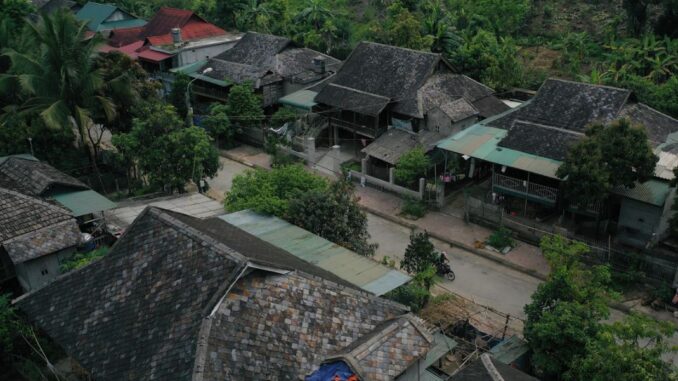
DIEN BIEN – Hundreds of houses on stilts with natural stone roofs and neat planning along both sides of the Da River are the highlight for tourists when coming to Muong Lay town.

Muong Lay town is more than 100 km from Dien Bien Phu city, located along both sides of the Da River, part of its territory is the intersection of the Da River, Nam Na River and Nam Lay Stream. The town is distinguished by rows of houses on stilts with stone roofs leaning against the mountains, lying close together.
This place is home to 9 ethnic communities, in which the Thai ethnic group accounts for 70% of the population, mainly white Thai people.

The Thai people here still keep the unique cultural heritages and traditional rituals of the white Thai people such as the boat racing festival, Kin Pang Then ceremony, ancient Thai Xoe…, especially the sticky house on stilts with stone roofs. nature with neat and airy planning along both sides of the river. Normally, houses on stilts in other localities of Son La, Thanh Hoa, Nghe An, Lai Chau… are only roofed with thatched grass, tiles, pro-cement sheets…
Previously, at the end of April 2010, the last of the more than 4,000 households in the town whose houses were below the water level of 195 m had to migrate to a higher position to lead the stream and close the Son La hydroelectric dam.

For Thai people, owning a traditional house on stilts with a stone roof is a pride. Each house usually uses more than 4,000 black, brown and five-colored stones.
The stone is quarried naturally from the lake bed of the Da River, when newly dug in the seam, the rock becomes soft, easy to split into thin pieces, edit and cut depending on the shape. After a period of exposure to the sun and rain, the stone hardens.

The stone tiles must be square, each side 20-30 cm. The two vertices of the stone must be cut into an isosceles triangle to fit together. When the section is not an isosceles triangle, when roofing, one tile will be tilted, tilted, and the whole row of tiles will be tilted.

In Na Lay ward, Muong Lay town, Ms. Tong Thi Que, 62 years old, is one of the households with the largest and most beautiful stilt house with a construction area of nearly 300 m2.
“My house has 5 rooms and 4 main columns. Before building the house, it takes a few years to prepare materials, only a few months to build. The roof uses more than 4,000 pieces of black stone. Black stone is exploited by people in the mountains along the Da River. Stone roofs are very durable, almost never having to be replaced. Often the wood breaks down before the stone,” said Ms. Que.

The stone roofs are stacked like fish scales, derived from the Thai lifestyle associated with the river environment, as the saying goes: “Xa eat by fire, Thai eat by water, H’mong eat by fog”. .
After decades of use, the stone color does not fade, is waterproof, has good cold resistance, heat resistance and is not corroded by the impact of the environment.

The stone used for roofing on stilts has many colors of black, brown, yellow, five-color… in which the black stone is the hardest.

Traditional Thai stilt houses used to be on the first floor to raise cattle and chickens, but now all have been moved out. This space is for threshing machines, drying agricultural products… and kept clean and ventilated.

In order to support the stone roof weighing a ton, the frame is always made of dozens of big trees. The system of beams, trusses, columns, braces, pedestals… creates a strong and cohesive connection.

All activities from the accommodation, cooking, and weaving take place on the second floor which is also the main part of the house. Depending on the condition of the family, this floor is divided into 3 or 5 compartments. The wall is made of wooden panels, the outside is a minimalist patterned railing.

The roads around the house on stilts are planned to be paved, with sidewalks and wide canopy trees for shade. Dien Bien’s climate is not cold in winter, not too hot in summer, Laos wind in April-May, not humid, so the houses on stilts are always airy and have a long life.
